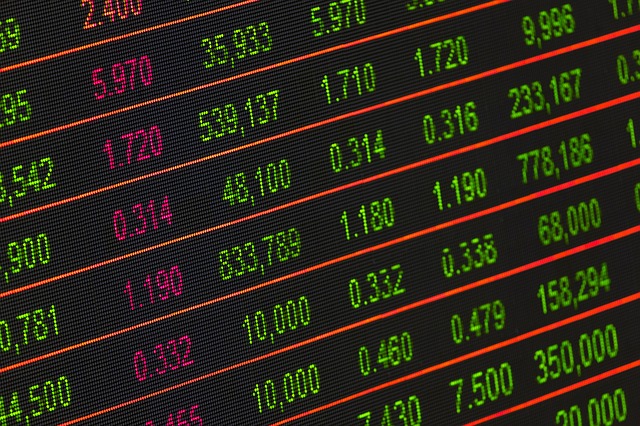Top Blue Chip Stocks, Dividend Stocks and more
View a list of top stocks on NASDAQ and NYSE
Stock Forecasts, Price Charts, Annual Reports and More
Stock Forecasts, Technical Analysis, Price Charts and More
Best Stocks Under $100
More Stock Tools
Hottest Stocks Right Now
Knowing the most active stocks could give you an opportunity to focus on investment opportunities as they become popular.
Here is a breakdown of what you need to know to get started.
What Is the Definition Of The Most Active Stocks?
The term "most active stocks" includes two categories:- Highest dollar volume, which refers to stocks that trade at surprisingly high amounts of money during a specific period, usually one day.
- Most shares traded, which refers to companies that trade the most shares during a specific period, again, usually one day.
An active stock includes any stock with a high number of trades (volume). The trading period isn't restricted to a certain time. Some companies have high volume trades during practically every trading day of the year.
For example, Apple Inc. (AAPL) has an average daily volume of over 110 million shares. It's a highly active stock because investors always want to transact in it.
"Most active stocks" are stocks with high trade volumes within a set period of time. Most often, that period is one day.
You could also set the time parameter to a few hours or a few days. What matters most is that you restrict the trading period. Outside of your determined trading period, the volume of shares doesn't matter. You only focus on the trading volume within your window.
For a hypothetical example of a most active stock, consider Company A. Investors usually trade about 10,000 shares of Company A per day. Suddenly, investors become very interested in the stock.
While Company A traded 10,000 shares on Monday, it traded 100,000 shares on Tuesday. No matter what happens on Wednesday, Company A counts as a most active stock for traders during the Tuesday rush.
How To Find the Most Active Stocks To Trade
It's nearly impossible for you to find the most active stocks to trade by looking at stock market tickers. There's just too much information for the human brain to process.Consider that the NASDAQ has more than 3,300 companies on its list. Only a computer with the right software could spot trends within so much data.
You can find the most active stocks to trade by using a trading service that helps you research investment opportunities.
You probably don't want to make all of your decisions based on numbers alone, but you can rely on investment research services, such as the screen above, to help you spot potential investments.
Once you have a list of opportunities, you can narrow your options to decide which company's shares fit your investment strategy and portfolio.
Dollar Volume Vs Share Volume
Let's take a closer look at dollar volume vs share volume to reach a better understanding of how they work and what you can learn from them.Share Volume
Share volume refers to the number of shares that were traded within a specific period. Take Tesla (TSLA) as an example. On March 5, 2021, the NASDAQ reported that Tesla had a share volume of about 89,395,000. That means that investors transacted in more than 89 million shares that day.Notice that the share volume doesn't tell you whether the stock's price has gone up or down. Hypothetically, investors could have transacted 89 million shares because the stock's price had fallen, making it look like a good time to buy. (In reality, Tesla closed at a higher-than-average price that day.)
On the other hand, investors could have purchased 89 million shares because they saw the company's value increasing and they didn't want to miss an opportunity to profit.
The share volume can only tell you how many trades happened during a specific period of time. You can assume that a high share volume means that investors have taken an interest in the company. You shouldn't necessarily assume that the interest is positive or negative.
Dollar Volume
Dollar volume tells you how much money investors transacted when trading a company's shares during a specific time period. You get the dollar volume by multiplying the number of trades made by the stock's price.Let's continue using Tesla as an example. If Tesla (TSLA) shares sell at $625 dollars, the dollar volume on March 5, 2021, would be $625 * 89,395,000, which comes to about $55.872 billion.
Armed with the share volume and dollar volume, you can learn quite a bit about how investors perceive a company's value over time. For example, if the dollar volume decreases while the share volume stays the same, you know that the company's value is decreasing.
For some reason, investors have decided that the company has been overvalued and the market is making a correction.
What Does High Average Daily Trading Volume Mean?
First, you need to recognize that financial participants use the term "average daily trading volume" in two ways. You must understand which definition someone is using before you can determine the underlying meaning behind the higher trading volume.For some investors and investment advisors, "average daily trading volume" refers to a stock's trading average during a specific day. For others, it means the average daily trading volume over X number of days.
You must define the number of days to gain deeper insight into the volume's meaning. For example, someone might say, "Company B had an average daily volume of 100,000 shares."
If that person gets the average from one week of trading (five days), that could mean something very different from a month of trading (20 to 30 days).
What Makes a Stock Become Most Active
A stock's trading volume can increase for a broad range of reasons. Common reasons include the company:- Releasing profit reports showing that they earned more money than investors expected.
- Emerging news reports that indicate one company will perform better than its competitors (potentially because the competitors have been adversely affected by weather events, technological issues, or data breaches.)
- Releasing new products or services that investors believe will revolutionize the industry.
Short-Term and Long-Term Trends
You need to know what time range people use when referring to most active stocks because you can't make a sound investment decision until you know whether they're talking about short-term or long-term trends.If you're looking at a one-day trend, you might want to use the information to make a quick profit. As soon as you learn that the stock's trading volume is skyrocketing, you buy shares and wait for the price to keep increasing. When you believe that the stock has reached its peak price, you sell and collect a profit.
Of course, you could miss the mark by selling the stock too early, which means you will miss out on a profit you could have earned. You could also hold on to the stock for too long. If the price crashes before you sell, you will lose money.
For a long-term trend, you want to purchase shares and keep them in your portfolio. Ideally, the increased trading volume – no matter how long it continues – will lead to a higher price on a stock that returns dividends and other financial benefits (such as management buybacks that reduce the share count and boost earnings per share figures).
How Long Will A Stock Rank As "Most Active"?
Technically, a stock could be ranked as "most active" forever. That would make the term meaningless, though, so people don't use it that way. Consider the above case of Apple (AAPL). Few call it a most active stock because it always has a high trade volume.Anything longer than one month of trading degrades the meaning of "most active." When judging your investment options, you should probably keep it within that range.
If you want to know how long a stock will experience high trade volumes, that's impossible to answer. Any company could suffer a setback that encourages investors to sell their shares.
Even Apple (AAPL) could make such a significant blunder that its shares would fall. It's unlikely, but it could happen. You can never make a certain move when trading stocks. At best, you can make an educated decision.
Most Active Stocks – Trading Strategies
Investors use a variety of trading strategies to earn money from the most active stocks. The following four strategies are popular options, but they only represent diverse approaches to investing with the most active stocks.Targeting Price Movements For Day Trading
Most active stocks attract a lot of attention. In many cases, increased attention in a company pushes share prices up as more people want to invest. If you pay close attention to most active stock trends, you might find that you can purchase shares at the beginning of a rally. As more people buy, the shares gain value.Day traders can make quick profits by targeting price movements, buying or selling stocks at just the right time.
Consider an investor who purchases 100 shares in Company A for $150 each. More people start to notice that the company has become a most active stock, so they start purchasing shares, too.
Over a few hours, the price jumps from $150 to $175 per share. At this point, the investor believes that the rally is nearing its conclusion. The person sells the shares at $175 and earns $2,500 in profit.
Day trading strategies always come with high risks. The investor's attempt to make money wouldn't work without the perfect timing.
Consider what would happen if the person hadn't noticed the most active stock until it reached $175. As more people invested, a share's price might reach $180. That's not enough money for the investor, so the person decides to wait.
Unfortunately, the market corrects as other investors realize the company can't support such a high price. Shares tumble to $150. Instead of making money, the investor loses $2,500 from the mistake.
Recognizing Long-Term Investment Opportunities
Most active stocks can come from companies with promising futures. The company might not have gotten much attention before. Now, people realize that it has exceptional promise. Perhaps the company finally managed to fulfill its promise to release a new product or it acquires a company that piques everyone's interest.Buying shares now and choosing to keep them in your portfolio could lead to long-term financial benefits.
Sure, investors would have made more money had they purchased shares before the company became popular. Missing an opportunity to earn a lot of money doesn't mean that an investor should also miss the opportunity to earn some money.
Monitoring Pre-Market Stock Movements
Pre-market stock movements could indicate that a company will become one of the day's most active stocks.This type of strategy involves following trading markets in Asia, Europe, and other locations.
If the stock starts to move up there, it might do the same when U.S. markets open.
Simulating The Futures Of Most Active Stocks
Some software attempts to simulate stock movements to determine whether a company will make the list of the day's most active stocks.Software can use real data to simulate fluctuations in the market, but no one can guarantee a result.
That's a critical thing to remember when relying on software to make investment decisions. You must combine analytics with human insights.
Most Active Stocks With High Volume
The most active stocks with high volumes change frequently. You can find the latest most active stocks with high volume by consulting the information below. The table above will show you:- The company's name.
- The company's stock ticker symbol.
- The last price investors paid for one share.
- The stock's score.
- The stock's volume.
- The stock's average volume.
- The stock's dollar volume.
Most Active Energy Stocks
Knowing the most active energy stocks will give you some insight into how the energy sector is evolving.The list of most active energy stocks will change frequently. Two popular stocks that frequently appear on the list include:
- Energy Select SPDR Fund (XLE) – An index that includes stock from companies like Exxon Mobil Corp (XOM), Chevron Corp (CVX), and ConocoPhillips (COP).
- Marathon Oil Corporation (MRO) – A Houston-based corporation with oil extraction operations in the United States, Canada, Equatorial Guinea, and Libya.
Most Active Gold Stocks
Gold is a global commodity that plays an essential role in the world economy. The list of most active gold stocks can change at any time. Two stocks commonly found on the list include:- SPDR Gold Trust (GLD) – A fund managed by State Street Global Advisors (SSGA) that focuses exclusively on gold bullion. SPDR Gold Trust is traded on the New York Stock Exchange, Arca, Hong Kong Stock Exchange, and Tokyo Stock Exchange.
- Barrick Gold (GOLD) – A Toronto-based mining company with operations throughout North America, South America, Africa, and the Middle East.
Most Active Small Cap Stocks
Small cap stocks belong to companies with $300 million to $2 billion in market capitalization.Finding the most active small cap stocks could give you an opportunity to invest in companies with plenty of room to grow. Two companies that frequently appear on the list of most active small cap stocks include:
- Gevo (GEVO) – A Colorado-based renewable chemicals and biofuels company that makes products for companies that want eco-friendly options for plastics, fibers, rubbers, and other polymers.
- Workhorse Group (WKHS) – A Cincinnati-based transportation company that manufactures electrically powered vehicles, including delivery vans, buses, and pickup trucks.
Most Active Japanese Stocks
The most active Japanese stocks can include companies that operate within Asia or globally. Two stocks that frequently appear on the list include:- Nissan Motor Corporation (NSANY) – Nissan is a global manufacturing company with nearly a century of experience designing and making vehicles.
- Nomura Holdings Inc. (NMR) – Nomura Holdings Inc. stands out as one of the world's most successful financial services companies. Its core members serve individuals, companies, and governments.
Most Active Stocks: Conclusion
The list of most active stocks can provide meaningful insight into which companies investors choose. There are a lot of variables that one must think about before purchasing stocks, though. Some critical factors to consider include:- How many days the stock has been active.
- The differences between share volume and dollar volume.
- Which investment strategy has the best opportunity to earn a profit.
- Whether you should consider the most active stock a short-term or long-term investment.
- Why investors have taken such a sudden interest in the company's stock.
Investing News

Why Did Stan Druckenmiller Sell Broadcom Stock?
In Q3, legendary macro investor Stan Druckenmiller sold his entire stake in Broadcom (NASDAQ:AVGO) at an average price of $306.16 per share. Although the semiconductor and software maker has been rising quickly for quite some time on a surge of AI enthusiasm, its stock is off by a little over 7 percent in the last […]

Why Is CoreWeave Stock Down So Much?
AI cloud computing business CoreWeave (NASDAQ:CRWV) has been through a remarkably volatile year. Though the stock has roughly doubled since going public early in 2025, its current price of $78.87 is far below the 52-week high of $187.00 it reached in June. Why is CoreWeave stock down so much since the middle of the year, […]

Why Did Stan Druckenmiller Buy MercadoLibre Stock?
In Q3, billionaire Stan Druckenmiller bought about 4,620 shares of Latin American eCommerce giant MercadoLibre (NASDAQ:MELI) through his Duquesne Family Office. Often described as the Amazon of Latin America, MercadoLibre has been a significant growth business for many years. With share prices having retreated below $2,000, however, MELI is well below the average price of […]

Is DocuSign Stock Undervalued?
Digital signature software business DocuSign (NASDAQ:DOCU) has been struggling over the past year as a market that’s generally friendly to tech firms has surged upward. Shares of DOCU are down more than 30 percent in the past 12 months, despite the business already being profitable and still posting respectable growth numbers. Is DocuSign undervalued now, […]

Is SentinelOne Stock Undervalued?
Cybersecurity major SentinelOne (NYSE:S) has struggled over several years, delivering very large losses to the shareholders who purchased it early on. Peaking at over $75 per share in 2021, S has gradually lost ground and now trades below $15. In the last 12 months, SentinelOne’s struggles have continued, with shares losing a further 33.7 percent. […]

Is Broadcom Stock on Sale?
Chip and software maker Broadcom (NASDAQ:AVGO) has been among the best stocks to own over the past couple of years as demand for AI chips has pushed share prices quickly higher. Though AVGO shares are still up more than 55 percent for the year, they have come somewhat down off of their November highs and […]
The #1 Stock Analysis Tool to Make Smarter Buy and Sell Decisions
Get started at Financhill, the #1 investment research platform that is your one-stop shop for finding the best trade ideas today.
-
Top Rated Stock Ideas
Financhill Stock Score is a proprietary stock rating engine that independently evaluates every company based on fundamental, technical, and sentiment criteria so you can find the highest rated stocks in the S&P 500, NASDAQ and NYSE. -
Best Stock Tools Platform
Whether you are looking for the best blue chip stocks, top dividend stocks, most shorted stocks, cheapest stocks today, highest dividend stocks or best stocks under $50, Financhill has got you covered and has so much more. -
Stocks Set To Soar & Crash
Financhill spots seasonal patterns in thousands of stocks so you can easily screen for the best stocks at this time of year. Want to know what stocks could rise 11% over the next 7 weeks with 91% accuracy based on past history? Our Seasonality Screener will surface the hottest stocks right now.
Featured in:






